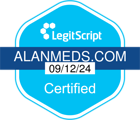Curious About Low Dose Naltrexone (LDN)? Here's What to Know
.png)
Low Dose Naltrexone (LDN) is a therapy gaining attention for its potential to gently support the body’s natural balance—especially in areas like inflammation, immune function, and mood regulation.
Originally FDA-approved in much higher doses (50 mg) for opioid and alcohol use disorders, LDN refers to the off-label use of naltrexone in much smaller amounts—typically between 1.5 mg and 4.5 mg. At this lower dose, it interacts with the body in entirely different, wellness-oriented ways.
If you’re exploring options for sustained energy, better sleep, or long-term well-being, LDN is a gentle, research-backed option worth learning about.
How Does LDN Work?
At low doses, LDN works by briefly blocking the body’s opioid receptors. While that may sound counterintuitive, this short-term blockade prompts the brain to compensate by producing more of its own natural opioids—endorphins and enkephalins.
These “feel-good” chemicals do far more than elevate mood:
- They help regulate immune function
- They support a balanced inflammatory response
- They may modulate pain perception
This unique mechanism is what makes LDN a compelling adjunct therapy in areas like chronic inflammation, immune dysregulation, and certain pain conditions.
Potential Benefits of Low Dose Naltrexone
✅ Helps Calm Inflammation
LDN is commonly used to support the body’s response to low-grade, chronic inflammation—whether from overexertion, stress, or environmental triggers. Over time, it may promote a more balanced, less reactive inflammatory state.
✅ Supports Immune Wellness
LDN has been shown to modulate immune activity, helping the system function smoothly without overreacting or underperforming. This has made it a popular option in both chronic and preventive wellness protocols.
✅ Enhances Mood and Sleep
By boosting endorphin production, LDN may contribute to improved emotional resilience, mental clarity, and restorative sleep. Many users describe feeling more balanced, energized, and grounded within weeks of starting.
✅ Well Tolerated, Long-Term Friendly
LDN is generally well tolerated when started at low doses and increased gradually. It’s non-habit-forming and often used as part of a long-term wellness toolkit, with minimal side effects for most people.
Is LDN Right for You?
LDN isn’t a cure-all, but it may be worth considering if you’re:
- Feeling chronically fatigued or inflamed
- Struggling with low resilience or poor sleep
- Looking for non-stimulant, non-sedating ways to support your well-being
- Interested in therapies that work with your body—not override it
While more research is underway, LDN’s safety profile and broad potential benefits make it a thoughtful option for those pursuing integrative approaches to health.
Ready to Learn More?
Alan Health offers clinically guided LDN therapy in a simple oral format—shipped directly to your door with expert support.
👉 Learn more about Low Dose Naltrexone here →
Resources
Younger, J. W., Noor, N., McCue, R., & Mackey, S. (2014). Low-dose naltrexone for the treatment of fibromyalgia: findings of a small, randomized, double-blind, placebo-controlled, counterbalanced, crossover trial. Arthritis & Rheumatology, 66(2), 529–538. https://doi.org/10.1002/art.38297
Raknes, G., Simonsen, P., & Småbrekke, L. (2022). Low-dose naltrexone in the treatment of chronic pain and inflammation: a review of clinical and preclinical data. Pharmacological Research, 175, 106037. https://doi.org/10.1016/j.phrs.2021.106037

.png)

.avif)


